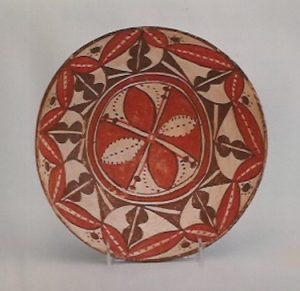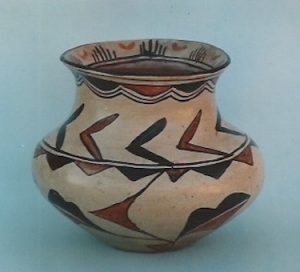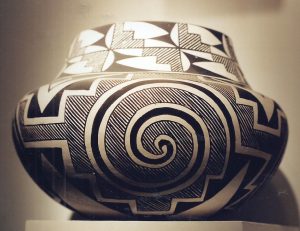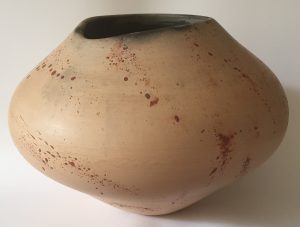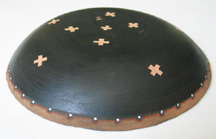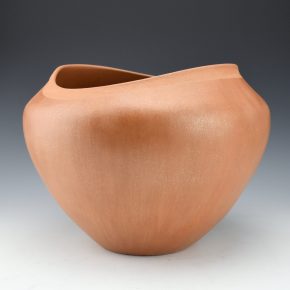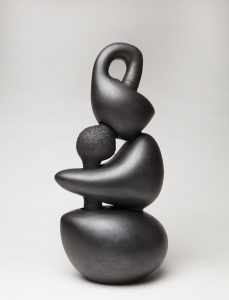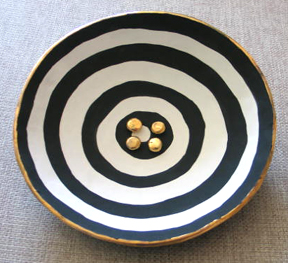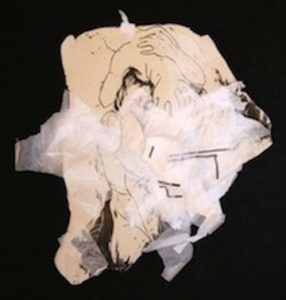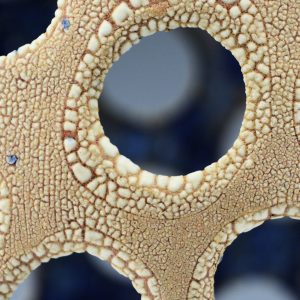Collector's Corner
FEMINISIM IN CLAY: Ceramic Art by Native American Woman
To some, ceramic art produced by Native Americans, particularly women, is simply craft. It doesn’t help that the entire output of these artists is referred to by the generic term pottery. Of course, skill and craft are involved in the creation of a ceramic work, but many pieces are rightly considered art. The discussion of what is craft and what constitutes art is an ancient one. During the Renaissance, Leonardo da Vinci considered painting to be the only true art, denigrating sculpture as craft, much to the chagrin of Michelangelo Buonarroti.
In many ways, ceramic art is sculpture and it very often includes the medium of painting. What ceramic artists create out of clay is often referred to as their “canvas.” However, they must first create the canvas. Unfortunately, this process is often called craft but, perhaps, a better term would be technique.
The discussion is more complicated with regard to ceramic works produced by Native American artists. Generally, Indigenous languages do not have a word for art. If something is worth creating, then it is worth investing time, skill, and artistry into creating it. Although the earliest ceramic works were functional, many are artistic masterpieces. Mimbres bowls are exquisite and are considered on a par with ancient Greek ceramics. The pottery produced by Ancestral Puebloans is coveted by museums and collectors worldwide. These ancient people were producing works with complex abstract designs long before the term abstract art was invented. One of the most fascinating aspects of this art form is that, until recently, only woman produced ceramic works. Among Native peoples, as in most cultures before modern times, there was a division of labor based on gender. Until the twentieth century, Native American ceramics were utilitarian with form following function. Decoration was another thing all together. It was here that women could express themselves artistically. Perhaps the reason that some do not hold Native ceramics in high regard is because pottery making was something traditionally done by women and they, therefore, consider it unimportant. This would not be the first instance of such bias. The Aztecs, the Inca, and, more recently, the Hawaiians considered featherwork to be among their most important art forms. The Europeans did not regard featherwork with the same esteem as the Indigenous people. To them, feathers, unlike gold, held no value. In addition, the featherwork most probably had been produced by women, making it even less valuable.
For centuries, pottery has been produced by women in the pueblos of the Southwest. These works were made by Native people not only to be used by their families but were traded far and wide even into what is today Mexico. With the arrival In 1878 of the Atchison, Topeka, and Santa Fe railroad into New Mexico, Native ceramics had a new audience. Anthropologists, traders, and tourists saw the artistry in these ceramic works. It was the women who, like any good entrepreneur, saw an opportunity and seized it. It was they who went to the railroad stops and sold their creations to the people who had come from the east.
At a time when archaeologists, anthropologists, and much of academia declared that Native Americans were a vanishing race, female artists at Isleta, San Ildefonso, Acoma, and other pueblos were countering this false narrative through their art. It was an idea that persisted well into the twentieth century. Rather than challenge political forces head-on, they expressed themselves by subtle, often coded means.
Polychrome Isleta bowl, foliate design, red and brown on cream, anonymous female artist, 3½” deep x 9½“ in diameter (ca. 1910). Collection of E. J. Guarino
Pueblo ceramic artists have always influenced one another. Isleta Pueblo exemplifies such inter-pueblo connections. In 1879 a group from Laguna Pueblo moved to Isleta because of a religious conflict between those who favored traditional Native religion and those who supported the proselytizing efforts of traders who were Protestants. Those who wanted to follow traditional religious beliefs and practices left Laguna Pueblo and eventually settled at Isleta, bringing with them the Laguna style of pottery. The arrival of the newcomers had an artistic impact on Isleta, creating a new style of pottery decoration, which came to be called Isleta Polychrome. Isleta ceramic artists adopted Laguna designs and acquired red and white slips and black mineral paint from the Laguna artists living among them. Today, such pieces are rare since the pottery output of Isleta was small. Looking at such pieces, it is clear that they are artistic variations on utilitarian forms and were made for sale by Isleta women to non-Natives.
Large Tunyo polychrome pot, San Ildefonso Pueblo, anonymous female artist, 7”tall x 8” wide (ca. 1910). Collection of E. J. Guarino
Before the ceramic revolution of Maria and Julian Martinez, the women of San Ildefonso Pueblo made an innovation that changed their pueblo’s pottery-making tradition. Before 1875, San Ildefonso ceramics had simple black designs painted gray-slipped bulbous forms. That changed sometime around 1880 when red paint was introduced into San Ildefonso designs. No one knows exactly how this transformation came about. It may have been the idea of one inspired woman or a group response to the competition of the more elegantly shaped and colorful ceramic vessels from Acoma and Laguna. This revolution seems to have been market driven. (For those who believe that there is no relationship between art and commerce, I refer them to the Renaissance.) At the same time, the shape of San Ildefonso ceramics evolved into graceful vessels with small bases, elegant necks and flared rims. The Tunyo polychrome aesthetic remained popular until the introduction of painted black ware by Maria and Julian Martinez in 1920. Five years later, the production of polychrome ceramics had ceased at San Ildefonso.
Black-on-white olla with Tularosa design by Juana Leno, Acoma, 7” x 9” (ca. 1975). Collection of E. J. Guarino
Like many other pueblo ceramic artists of the mid to late 20th century, Juana Leno took inspiration from ancient Puebloan pottery. It was a way of continuing time-honored traditions as well as expressing pride in one’s heritage. The various techniques and skills needed to create a ceramic work of art were passed down within families from mother to daughter to granddaughter. This remains largely true today though there are now many male Native ceramic artists.
Ancient Tularosa Black-on-White ceramics inspired Leno because they are well-polished, have a lustrous sheen, and are often covered with spectacular designs. This ancient pottery is a type of Cibola White Ware found at archaeological sites in east-central Arizona and west-central New Mexico,
By making their ceramics in the traditional manner and decorating them with age-old designs Pueblo artists were stating, “We are still here and this is who we are.” The work created by the matriarchs of Pueblo pottery – Nampeyo, Maria Martinez, Lucy Lewis, Margaret Tafoya, and Marie Z. Chino – was produced at a time when it was believed that traditional ways were being lost. The arrival of the railroads brought tourists who bought up Pueblo pottery first as souvenirs and later as art objects. Farsighted museum curators also arrived, collecting pieces that became an important part of many Eastern museum collections. Pueblo artists began to create works whose purpose was no longer functional, but artistic. This creative tradition continues to evolve to this day.
Contemporary Native artists have taken a bolder, more subversive approach using irony, humor, and satire to make political and social points. Stereotypes are appropriated for their own purposes and overturned. These artists no longer have to rely on coded messages. They are empowered to express themselves openly and they do so.
Pot with Paint Spatter by Jody Folwell, Santa Clara Pueblo, Native clay, acrylic paint, 10“ x 11“ (2015). Collection of E. J. Guarino
An artist’s vision often outpaces the expectations of collectors, curators, and critics since innovations are very different from shortcuts and often require more time, rather than less, to execute. Truly great artists know this. Although they may push the boundaries of their art, artists know that innovation must be artistically grounded, not a mere gimmick. Challenging expectations is always risky for any artist but it is even more so for Native American artists, in particular, ceramic artists. An avant-garde pioneer, Jody Folwell was one of the first artists to challenge the status quo.
Although, over the years, the artist’s work has been showered with accolades, this was not always the case. Collectors and curators had very specific expectations with regard to ceramics produced by Pueblo artists and Jody Folwell’s pieces challenged these long-held notions. Her creations were unsettling, controversial, unpredictable, and artistically thrilling – they still are. Despite her status as a major artist and a Living Legend, Ms. Folwell is amazingly unpretentious. Jody Folwell is one of the pioneers of contemporary Native American ceramic art. Some of her pieces have an uneven lip while others are asymmetrical. Other works are finely polished explorations of color and form, bearing no painted designs whatsoever. At times, the artist has incorporated letters, words, symbols, and unexpected imagery on her clay works or carved imagery into a piece. She sometimes also references pop culture as well as designs from other Native groups. To many, Ms. Folwell’s statement pieces, in which she often employs acrylic paints, are the most shocking and disturbing aspect of her art. Such works reveal the artist’s strong sense of social justice and are often bitingly satiric.
Her Pot with Paint Spatter is an example of her daring as an artist. It is asymmetrical in that it has an uneven lip but, more surprisingly, it is a plain ware pot that is covered in drips and splatters of red paint. According to the artist, she had just finished reading a book about Jackson Pollock and it just came into her head to decorate this particular work with spatters of paint. One can almost picture the artist gleefully walking around the piece with a paintbrush, flicking paint at it. Jody Folwell is a master of her medium, so much so that she can successfully expand its boundaries in ways that few other ceramic artists dare.
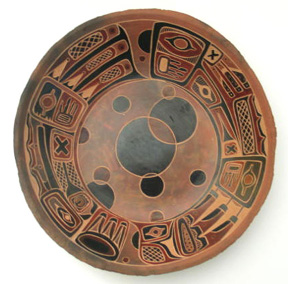
Plate with Northwest Coast Imagery and Geometric Designs (Reverse)
In Plate with Northwest Coast Imagery and Geometric Designs, Susan Folwell fully integrated Northwest Coast patterns into her artistic vision. The Northwest Coast symbols seem to swirl around interconnected circles that are reminiscent of the work of Wassily Kandinsky, the Russian abstract painter. By employing two different geometric styles a tension, as well as a conversation, is set up. The front of the piece has a refined quality while the reverse, covered with Santa Clara crosses and painted to resemble sewn leather, has a rawness to it, which also creates an artistic tension and visual interest between the two sections of the plate.
Eye See You, seed pot by Susan Folwell, Santa Clara Pueblo, 4“h x 17“ in diameter (2011). Collection of E. J. Guarino
A ceramic work covered with eyes is not to everyone’s taste, but Eye See You, would certainly be the envy of any self-respecting surrealist. In fact, the piece is reminiscent of the 1929 film Un Chien Andalou by Luis Buñuel and Salvador Dalí as well as the Dalí dreamscape in Alfred Hitchcock’s 1945 thriller Spellbound. The piece is a contemporary take on the seed pot form; it is shaped like an eyeball and has a cork stuck in it, which adds to its twisted humor.
Savage Nation by Kaa Folwell, Santa Clara Pueblo, ceramic plate with acrylic paint, 10” in diameter at widest point (2012). Collection of E. J. Guarino
According to the artist, quite a number of people who viewed Savage Nation completely misinterpreted her intent, mistakenly thinking she was stereotyping Native woman and they found the piece offensive. Ms. Folwell had something quite different in mind when she created Savage Nation. The figure at the center of the plate is being served up just the way Americans like – scantily clad, wearing “war paint,” holding a tomahawk, staring defiantly out at the viewer and poised to attack. However, on closer inspection, the tomahawk is piercing a heart and in her left hand, the “warrior” holds a sack bearing the words “Bag of” followed by the image of a broken heart. Between the two parts of the heart is a dollar sign. This figure represents the way Native people – both male and female – have been viewed by mainstream culture and portrayed in the media as violent and overly sexual. It is an image that is, for many, both frightening and titillating. The key to Folwell’s piece is her use of red, white and blue, though within the blue are marks known as Santa Clara crosses. The imagery and colors, and the words Savage Nation make it clear that the artist is challenging us to reconsider long-held beliefs about Native people and the United States, leaving us to consider who really are the savages.
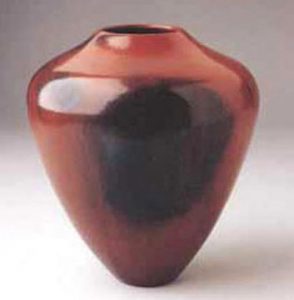
Pitch-coated red-brown vase with fire clouds by Alice Cling, Navajo (Diné), 11”h x 7½”w (c.2002). Collection of E. J. Guarino
Considered the matriarch of Navajo ceramics, Alice Cling is credited with transforming Navajo pottery from folk art to fine art. Many believe that she is to Navajo pottery what Nampeyo, Maria Martinez, and Lucy Lewis are to Pueblo pottery. Before Alice Cling, Navajo pottery looked crude and can best be described as clunky. However, what it lacked in elegance, it more than made up for in charm. Early vessels were undecorated and utilitarian. Sometimes a potter would apply a small band of clay around the rim of a pot for decoration (something Alice Clings sometimes still does). This technique, known as appliqué, later allowed Navajo potters to add animals and figures to their pots, creating scenes of Navajo life. Alice Cling stripped Navajo ceramics to its bare essentials. Her work has a minimalist quality. The “decoration” of her pieces depends on the whim of fire. As with all Navajo pottery, her vessels are coated in piñon pitch, which acts as a glaze but, unlike earlier Navajo pottery, Cling’s are highly polished. When fired, the pitch creates smoke clouds which, because of the high burnish, look more like what is termed a blush. The artist cannot force the fire to create these striking variations in color in a specific spot, but can only urge it to do so. Alice Cling’s work is an elegant exploration of form and hue. Each piece is a rich burnt red to sienna color that is enhanced with fire patterns.
Asymmetric Bowl with Lightning Rim by Christine Nofchissey McHorse, Navajo, micaceous clay and vertically polished, 10.5”w x 7.75” h ( ? ). Collection of E. J. Guarino
Micaceous clay had always been used to create cookware, but in using this material Christine McHorse transcends this utilitarian tradition. Asymmetric Bowl with Lightning Rim, for example, references traditional Pueblo forms, but is extremely thin-walled, with a lightning band carved into the rim. The piece is polished vertically which creates a striation which, combined with the piece’s asymmetrical form, give it an elegant look. McHorse incorporates pueblo ceramic techniques into her work but also draws on her Navajo heritage in creating her unique pieces. Like Alice Cling, she has taken Navajo pottery in new and exciting directions. Over time, her work has become undecorated and abstract, more often resembling contemporary sculpture than pottery and blurring distinctions between the two art forms.
Free Radical by Christine Nofchissey McHorse, micaceous clay, Navajo, 20” x 9.25” (2012). Collection of Barbara and Eric Dobkin. Photo from Spoken Through Clay courtesy of Charles King.
Christine McHorse continues to experiment with the concepts of shape, line, texture, and hue. Her work has come to be considered sculpture and is often compared to that of Henry Moore and Constantin Brâncuși.
White Bowl with Woven Reeds by Jacquie Stevens, Winnebago, 10”h x 14”w, 44” circumference (September 2008). Collection of E. J. Guarino.
Jacquie Stevens creates large, unusually shaped works, many of which contain reeds, stones, leather, wood, or wicker. Her pieces are unglazed and unpolished and are deceptively simple in appearance. White Bowl with Woven Reeds includes reeds as part of the piece, suggesting the origins of pottery in basket making. Such works are striking and the viewer can only wonder how the artist was able to incorporate such disparate elements in creating the ceramic vessel.
Untitled plate with white-on-black concentric circles and four “golden stones” by Anita Fields, Osage, ceramic, gold leaf, gold luster glaze, 9¾” in diameter (2010). Collection of E. J. Guarino
Much like Op art, an untitled white-on-black plate with concentric circles by Anita Fields has a mesmerizing effect, drawing the viewer inward toward the four “golden stones” at the work’s center. The work looks like some sort of futuristic prospector’s pan containing gold nuggets. As humans, when we encounter a work of art we immediately begin to question what it might “mean.” However, the piece really doesn’t have to have a meaning in the usual sense of that word. Perhaps it is meaning enough that Anita Fields took an everyday functional object and through her artistry transformed it into something of beauty and wonder.
Transparency #6 by Rose B. Simpson, Santa Clara Pueblo, inlaid ceramic, tracing paper, 11” x 12” (2011). Collection of E. J. Guarino
Transparency #6 bears the image of two nude figures locked in a passionate embrace, but the gender of the lovers is intentionally obscured by the addition of tracing paper and small pieces of ceramic, leaving the viewer to wonder if it is a mixed sex or same-sex couple. If same-sex, is the pair male or female? In the end, perhaps it doesn’t matter and that may be the point. It is only after much reflection that one realizes that not only is the form of Transparency #6 controversial, but its subject matter may be as well.
Also hidden in the piece is a word, but all that can be made out of it are the letters nd. When asked about this the artist said, “It was concealed on purpose. I write a lot of poetry and I like hiding the words in my work sometimes, the poem sometimes is written where two parts are glued together. I set the essence of the words inside the piece, hoping they will transform it without commanding it.”
This work is unusual in that it is part of a series of eight similar, though unique, works. Each piece has slightly different dimensions as well as a singular image. Since the transparencies are made of thin ceramic, they are extremely fragile, suggestive of human frailty. The artist has stated that this series is about being truthful since she often struggles with just how much of herself she should reveal in her work.
Artifice multi-hole Breach Series vessel by Courtney M. Leonard, Shinnecock Nation, mica clay, handmade glazes with blue slip on interior, 9.25”w x 12.5”h (2016). Collection of E. J. Guarino
Artifice multi-hole Breach Series (detail)
Much of Courtney M. Leonard’s work is a response to the maritime influences that shaped the lives of her ancestors. It is from her knowledge of the Shinnecock’s seafaring past that she draws inspiration for her ceramic art. Her piece titled Artifice appears to be made out of coral or bone, giving it a disquieting, yet compelling quality. One of the most fascinating aspects of the piece is that it is designed to sit either on its end or its side, but what intrigues people most is the textual quality of the piece; many can’t resist touching it. This work was inspired by the structures made for reviving coral growth and is an exploration of historical ties to water and whale; imposed law; and the current relationship of material sustainability.
Rick Welch, an esteemed collector of contemporary Native American ceramics once said, “With regard to Native Americans and the making of political statements, I have no doubt that none of those . . . matriarchs or the grandmothers of the matriarchs ever thought in those terms. But I believe that everything we do, every choice we make is a political statement. It is irrelevant whether or not [historic Pueblo potters] ever had a ‘political thought’ in their heads. It’s no less political just because it’s unconscious.” That is a profound and thought-provoking statement. Artists have the ability to speak to us through time and space. Native American woman, most of them anonymous, have been doing so through their ceramic art for hundreds of years. Well into the twentieth century, ceramic art produced by Native American women was not overtly political. That has changed. Artists such as Jody, Susan, and Kaa Folwell often use their art to make social and political commentary. Courtney M. Leonard’s work draws the viewer to consider environmental issues. These artists are free to express themselves in any way they choose through their art. Today, female Native artists can express themselves through any medium they choose – painting, sculpture, printmaking, photography, video, and performance art. In the past, the only means of artistic expression Native woman had available to them were pottery making, beadwork, and basketry. These so-called traditional arts are still produced today, but Native artists use them in new and exciting ways. Some of the most exciting contemporary art is being produced by Native Americans, many of whom are female and many of whom choose to express themselves through ceramics.



